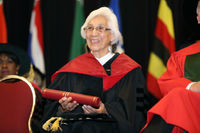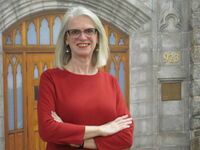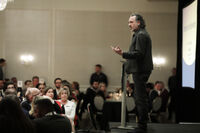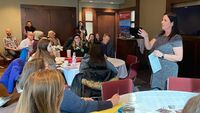By Michelle Brunet |
At her Indian Brook, Nova Scotia home, Dr. Isabelle Knockwood takes out a red tube. It was given to the Mi’kmaw elder when she was awarded an Honorary Degree—a Doctor of Civil Law—from Saint Mary’s University at Fall Convocation in 2013.
“In honouring Isabelle Toney-Shay Knockwood with this degree we are also honouring her ancestors, her parents, children and grandchildren, and her great grandchildren for seven generations,” states an excerpt from the scroll inside the tube. “She will accept this Honourary Degree for her life’s work on behalf of all residential school students, many of whom died before they heard an official apology or received compensation for their trauma.”
Now in her 80s, Knockwood’s lifelong pursuit of social justice for Aboriginal people, as well as other cultural groups and women, has involved many inspiring achievements, from working with homeless people in Boston and Toronto and with the American Indian Movement to testifying before the Truth and Reconciliation Commission of Canada, and advocating for specialized education for Aboriginal urban youth.
Even today, Knockwood has numerous projects on the go, such as writing a booklet on the history of the Shubenacadie River, a collection of short stories for kids, and an account of the ancient Mi’kmaq based on the Debert, NS archaeological habitation.
At her desk, she points up to large text that states another undertaking she’s working on: “My goal is to write a report to the Truth and Reconciliation Commission that accurately represents the perceptions of former students of the Shubenacadie Indian Residential School,” she says, “regarding their reactions to Canada’s 2008 apology to residential school survivors as stated in their videotaped and transcribed interviews.”
With Knockwood’s warm smile and laugh, thoughtfulness and wisdom, it is no surprise she has a talent for helping others open up. Her personal talking stick has been held by over 1,000 people.
“The talking stick is an instrument of free speech that gives people who were once silenced an opportunity to say what is on their minds in the language they choose,” writes Knockwood in her book Out of the Depths: The Experiences of Mi’kmaw Children at the Indian Residential School at Shubenacadie, Nova Scotia (Roseway Publishing/Fernwood Publishing, 4th edition forthcoming).
Knockwood herself was a student at the Shubenacadie Indian Residential School from 1936, when she was five years old, to 1947. Four decades later, in 1985, she started to interview people who had also attended the school.
In the late 1980s, Knockwood enrolled at Saint Mary’s University to complete a Bachelor degree in Anthropology with a minor in English. In one of her classes, an Autobiography and Biography course taught by Dr. Gillian Thomas, Knockwood read something to the class. It was something she wrote about the first night she spent at the residential school. Thomas asked her if she had written any more on the subject. Knockwood showed up with five or six plastic bags full of interviews, writings, and photographs.
Thomas helped Knockwood organize her work and thoughts into a book. She also encouraged Knockwood—who received threats for writing the book and became overwhelmed with hearing so much from others about the abuse that went on at the school—to keep going.
In 1992, the first edition of Out of the Depths was published. The same year Knockwood graduated from SMU with her Bachelor of Arts.
It was around that time that Knockwood also came up with an idea for Saint Mary’s—something she is still determined to see through today. “What I would like to see happen at SMU is the establishment of a study and resource lounge for Aboriginal students because indigenous knowledge is specialized knowledge—as in, it is culture-specific,” she says. “There are over 100 Aboriginal students registered at Saint Mary’s right now.”
She envisions the centre to be a repository of information that accurately and unbiasedly details the history, cultures, and stories of the Mi’kmaq and other Aboriginal people.
“The story of the First people and the land prior to European contact has never been written because Indigenous people pass on information from one generation to the next through the spoken word and not the written word,” explains Knockwood. “And the texts at European contact were written by the British and the French who used derogatory terms such as ‘savages’ and ‘heathens.’” They described Aboriginal people as having “no belief system, no political structure and no private ownership.”
Texts by European writers from the 15th to 19th century omit the “female aspect of history, spirituality, politics, and gender roles,” as well, says Knockwood. She notes too that by the time students get to university, their knowledge of authentic Indigenous history is limited or non-existent. Saint Mary’s students could be the core group to gather information, says Knockwood. They could collect stories, interviews, photographs, letters, family histories, and other forms of information, not found online or in libraries, from the homes and memories of people living in Native communities. The students could then store and present what they’ve discovered at the Aboriginal centre on campus.
“Saint Mary’s would benefit from having this collection of our specialized knowledge too,” affirms Knockwood.
A continuous learner—she not only has degrees from Saint Mary’s but also a Masters degree in Women Studies from Goddard College—Knockwood says we can learn from people of all ages. “It’s not just the elders who teach, children teach too,” she says.
One significant experience for Knockwood was when she and other residential school survivors met with Aboriginal healers from across North and South America, arranged by the Aboriginal Healing Foundation. “We learned a lot from them,” says Knockwood. “One of my first teachers was a Hopi medicine man. I’m telling you, he was a powerful man. It was awesome, just awesome…I had a good life. I met a lot of exciting people.”




